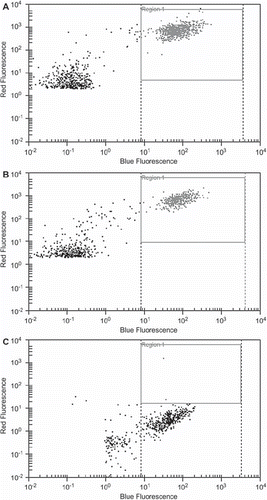Figures & data
Figure 1. EpCAM expression of two luminal cell lines (A) MCF-7, (B) ZR-75-1 and one basal like (C) Hs578T cell line. MCF-7 and ZR-75-1 cells have a significantly higher EpCAM expression than Hs 578T cells (p < 0.001).

Table I. Recovery rates of spiking experiments of the EpCAM (+) cell lines, MCF-7 and ZR-75-1, and the EpCAM (−) cell line, Hs 578T. To enrich tumor cells one EpCAM dependent assay, MACS HEA MicroBeads®, and one EpCAM independent assay, OncoQuick® plus, were used.
Figure 2. Box plots demonstrating that basal like Hs 578T EpCAM (−) tumor cells are enriched to a significant lesser extent with the EpCAM dependent enrichment method, MACS HEA MicroBeads®, compared to luminal EpCAM (+) cell lines, MCF-7 and ZR-75-1. Vice versa, an EpCAM independent enrichment method, OncoQuick® plus, enriches EpCAM (−) and EpCAM (+) tumor cells without significant difference. MACS HEA MicroBeads® recovered significantly more EpCAM (+) cells compared to OncoQuick® plus. Vice versa, OncoQuick® plus recovered significantly more of EpCAM (−) Hs 578T tumor cells.

Table II. Detection rates of circulating tumor cells (CTCs) by two enrichment technologies according to the clinical pathological patient variables at the time of their diagnosis.
Table III. CTC detection rates according to the two CTC enrichment methods, MACS HEA MicroBeads® and OncoQuick® plus, of diverse breast cancer subtypes in 26 breast cancer patients.

